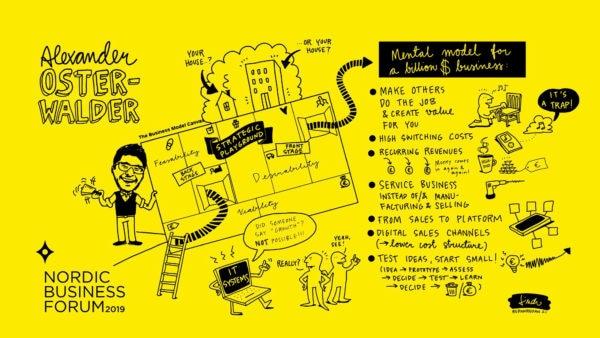3Oct2019
“Growth is good for everyone in the value chain, and it should always be top of mind for business leaders. However, the truth is that finding sustainable and repeatable growth is getting harder. Sometimes we hold on to our old growth playbook for too long, or our world is disrupted by a more agile start-up in ways we could have never imagined.” – Geoff Moore author of Crossing the Chasm.
Growth is a business imperative. Yet, has never been harder. In her bestselling book Growth IQ, Tiffani Bova of Salesforce argues that there is no single route to growing an organization, but many things need to be in place. And Salesforce should have some understanding of growth — it began life in 1999 with four people in a one-bedroom apartment in San Francisco and is now a global organization with 35,000 employees and revenue of $13.2 billion. Bova identifies ten growth paths:
- Customer experience
- Customer base penetration
- Market acceleration
- Product expansion
- Customer and product diversification
- Optimize sales
- Churn (minimize defection)
- Partnerships
- Co-opetition
- Unconventional strategies
What Bova is sure about is that it is never one single thing that enables a company to grow. There is no silver bullet. We at Brightline agree. But there is something else at work here. The reality is that companies know the path or paths to growth. They know they need to optimize sales. They know they need to develop partnerships with companies in related markets, perhaps even with competitors.
They know what it takes to grow, but are often unable to translate this knowledge into action and results. And, as the growth plan encounters problems, they decide to reorganize. It is logical to think again about who has responsibility for what and where, and which resources are being utilized.
The trouble is that re-organization is often a path to further confusion. It is a universal response to a stalled growth plan, but it doesn’t work. A report by the Boston Consulting Group found that, in a study of executives worldwide, 90 percent recently carried out a reorg within their company. Less than half were successful.
So, what can an organization do to ensure its growth plan actually delivers?
Build a growth culture.
One obstacle businesses face when trying to grow is a foundational issue rather than an operational one. The foundation of a growth-oriented culture begins with acknowledging that delivering on your growth strategy is just as important as designing it. No matter how determined or gifted your employees are, a lack of drive or ability to bring great ideas to life will be a major hindrance to progress.
One way to ensure employees have the tools to follow through with new ideas and strategies is to equip them with the right training and technologies. And yet, a full 35 percent of respondents to a Twitter survey carried out by Quartz Creative in partnership with the Brightline Initiative reported that their companies “never” hold strategic competence development training sessions. A failure to invest in future-planning is a major oversight, but it can be corrected by developing recurrent, data-driven learning and development programming that puts implementation at its core.
Track the plan.
For there to be accountability in delivering on a growth strategy, there must be a concrete system to analyze whether solutions are on track. Leaders should closely track how well a strategy is being implemented so they can proactively identify challenges when they arise.
On the technology side, there are a plethora of platforms that enable companies to be smart about creating and delivering a plan for growth, including data-driven competitive intelligence tools and customer feedback platforms. Again, however, this is an arena where many companies may be falling short: 31 percent of Twitter respondents said that their companies “never” implement customer feedback into strategic decision-making, and 32 percent noted a complete lack of utilization of competitive intelligence.
Encourage smart simplicity.
Be bold, stay focused, and keep it as simple as possible. In a fast-paced environment and a complex business landscape, there’s value in simplicity. A growth strategy should minimize bureaucracy. Less bureaucracy will result in faster decision making, reduced complexity, and more transparency. Ultimately, smart simplicity will allow teams to be more responsive to changes, risks, and opportunities.
Create growth teams.
Someone must take responsibility. There is a need for consolidated point-people and go-to teams who handle the growth strategy. For most organizations, there’s no one-size-fits-all role dubbed “growth strategy implementer extraordinaire”— so, having a consolidated, accessible squad of point-people dedicated to strategic tasks is an important part of growth and prosperity. Many companies, however, fail to consider this key resource when it comes to organizational structure and responsibility delegation: The Twitter poll found that more than half (52 percent) of respondents’ organizations do not have a centralized function to oversee strategy, and 18 percent indicated that they believe their company “should” dedicate such a team.
Strategic point-people may manifest as a centralized group of employees, or they may be spread throughout an organization in a lateral manner. Regardless of whether these individuals are part of one team or spread across many, they should be provided the resources to collaborate and ensure that they’re on the same page, and that their teams are working toward the same growth goals.
These employees may oversee regular reinforcement of strategic delivery, as well as both inter- and intra- company communication and cooperation. These individuals may also be responsible for ensuring that ongoing strategic efforts are working before the company commits to dreaming up new ones.
Fail fast to learn fast—and be sure to celebrate wins.
Accountability is a core pillar of company culture that’s crucial for effectively delivering growth. Companies must hold employees, executives, and partners accountable for delivering upon strategy that’s taken invaluable time and energy to develop. A company culture that champions making decisions and sticking with them—as well as accepting that failure is a natural part of growth—will encourage teams to think boldly when it comes to strategic brainstorming and rebound quickly in the event that a decision isn’t up to snuff. After all, it’s often easier to course-correct than it is to recover after being left in the dust by competitors.
According to an EIU survey, in collaboration with Brightline Initiative, almost a quarter of respondents cited cultural attitudes as a significant barrier to strategy implementation. To foster a culture of transparency, business leaders should empower teams to experiment and mitigate uneasiness surrounding the fear of failure.
Develop robust plans but allow for missteps.
Part of this process involves clear-cut communication across all tiers of the organization. Using simple, concise language and encouraging open discussion of problem areas is key to long-term success. It’s also important to recognize and celebrate “wins” by publicly acknowledging when strategy succeeds.
Achieving growth isn’t easy. A lot of people, resources, technologies and ideas need to be in alignment. But, it is the challenge that every business has to face. Because if you are not growing, what are you doing?
This article was contributed by NBForum 2019 partner the Brightline Initiative. The author of this article is Ricardo Viana Vargas, Executive Director of the Brightline Initiative.
Resources:
- Ten Guiding Principles. Brightline Initiative.
- Closing the Gap: Designing and Delivering a Strategy that Works. Special Report written by The Economist Intelligence Unit in collaboration with Brightline Initiative, 2017.
- If your strategy isn’t working you probably need more than a reorg. Brightline Initiative. Article, May 2018.
- Tiffani Bova. Growth IQ: Get smarter about the choices that will make or break your business. Portfolio-Penguin, New York, New York, August 14, 2018.
- The three Cs of better strategy implementation. Brightline Initiative. Article, November 2018.

 by:
by: 
